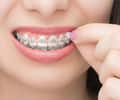After orthodontic treatment is complete, your child will have their braces removed - marking the end to the most challenging part of the road to a beautiful smile and straight teeth. At this point, your orthodontist may require that your child wear a dental retainer. Believe them when they say that the success of the orthodontic treatment depends upon diligently wearing a retainer.
The use of retainers after braces is an essential part of the continuing maintenance of teeth and will go a long way toward keeping the same bite and smile that the braces have formed over the last few years.
Your orthodontist, who performed the orthodontic treatment, will fabricate your retainers. The retainers are made by taking a dental impression of the upper and lower straightened teeth. The impression is sent to a dental laboratory, and the retainers are made from wire and acrylic material. The dental retainers are sent back to the orthodontist who fits them on your child's teeth to secure them. These retainers are worn for several years, or in some cases, indefinitely.
Why Are Retainers Necessary?
Before your child got braces, the orthodontist carefully analyzed their teeth and jaws to develop the best treatment plan to move your child's teeth into proper alignment. Because teeth are securely held in place by bone and ligaments, it is no easy feat to move them. The bite is corrected, and your child's teeth look great, but they are not yet stabilized in their new spots. It takes time for the bone and ligaments to tighten and hold the teeth securely in place.
Braces put forces on the teeth to trigger changes in the ligaments and bone to allow movement. This process is slow and carefully planned, and the teeth eventually move into the correct position.
Retainers are vital to preserving the great results that the orthodontist was able to achieve. Without wearing a retainer after braces, your child's teeth could slowly drift out of alignment. It will be back to the drawing board!
What Types of Retainers Are Available?
There are two types of retainers for after braces: fixed and removable. Your orthodontist will work with you to help identify which type of retainer your child needs. Some dental issues may require particular retainers, and some retainers can be more high-maintenance than others.
Fixed Retainers: The fixed type of retainer is usually a thin wire worn across the back of the lower or upper front teeth, which bonds in place with a cement similar to that applied on braces' brackets. Because this type of wire stretches across several teeth, a floss threader or similar cleaning device must be used to access the spaces between the teeth, which is similar to how people with braces have to floss. Even though this type of retainer takes a little more work to keep clean, it has the best outcome because the bonded wire will hold the newly straightened teeth in perfect formation.
Removable Retainers: The removable type of retainers are made for the upper and lower teeth and fit each arch made with acrylic and a wire placed across the teeth. Since it is removable, this type of dental retainer makes it easier to clean your teeth, but the patient has to remember to wear it daily. Your orthodontist will instruct you to wear your dental retainers. They may have you wear them daily for a few months, nightly for many years, or even for the rest of your life.
A disadvantage of a removable retainer after braces is that it can be lost or damaged and can even melt or change shape if exposed to high heat. When wrapping retainers in tissues or paper towels, they tend to get thrown out. Most orthodontists charge a few hundred dollars to replace retainers, so people with removable retainers should find a safe way to store them in a plastic retainer case.
Retainer Maintenance
Throughout (and after) the use of both types of retainers, periodic maintenance is required, with routine dental visits to check for cavities and clean the straightened teeth. Your dentist or dental hygienist can inspect in and around a fixed retainer to ensure that it is secure, in place and that the teeth supporting it are free of plaque and tartar.
Your child's orthodontist will also give you instructions for cleaning removable retainers, which could include brushing with toothpaste before wearing the retainer and after removal or the use of an effervescent cleanser.
Most patients have invested a lot of money in orthodontic care. Wearing a retainer after braces is an integral part of the treatment to ensure a lifetime of happy and straight smiles.
Oral Care Center articles are reviewed by an oral health medical professional. This information is for educational purposes only. This content is not intended to be a substitute for professional medical advice, diagnosis or treatment. Always seek the advice of your dentist, physician or other qualified healthcare provider.
ORAL HEALTH QUIZ
What's behind your smile?
Take our Oral Health assessment to get the most from your oral care routine
ORAL HEALTH QUIZ
What's behind your smile?
Take our Oral Health assessment to get the most from your oral care routine
Join Us
Get the best of your oral health routine and take it to the next level with expert advice, recommendations, products and solutions and special offers.
Join Us
Get the best of your oral health routine and take it to the next level with expert advice, recommendations, products and solutions and special offers.















